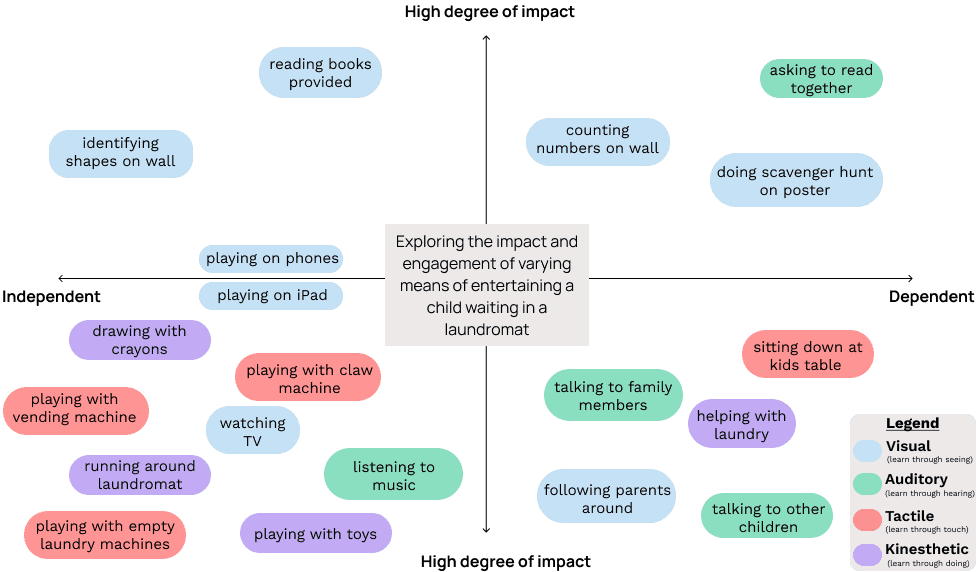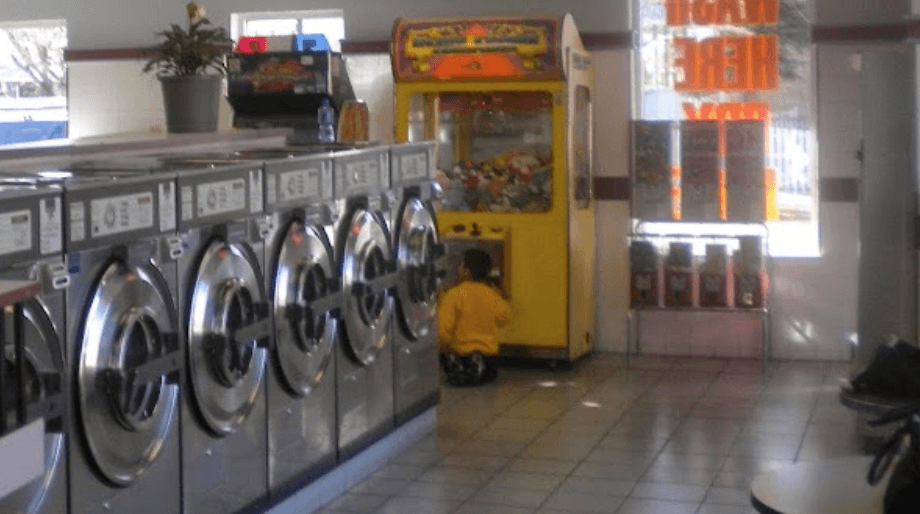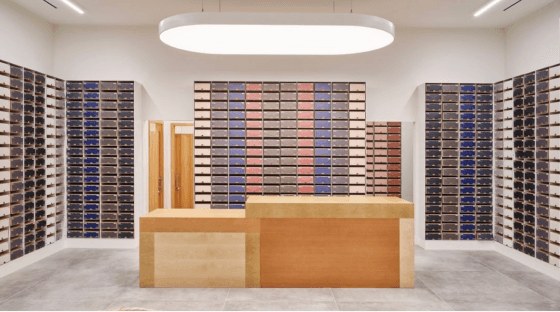
Planting Seeds of Justice
Designing critical interventions to improve the experience of children visiting their incarcerated loved ones
project partners & collaborators

Laundry Cares Foundation
An organization that sets out to enrich communities through programming that addresses unmet needs of laundry customers.
Team Palmy - Centering system-impacted folks
The stakeholder group my team was charged with was system-impacted individuals. This meant focusing on their needs as well as facilitating opportunities for collaborative design.
(left to right) Ana Carvallo, Yaritza Chavez, Patrick Giavelli, Lindsay Lipschultz, & sahibzada mayed
Becca's Place @Cook County DOC
An early learning center that served as the inspiration for the project. It was created in memory of Becca Ruidl, a librarian who was especially passionate about changing expected outcomes for children in vulnerable situations.
Read more about it
Women's Justice Institute
WJI is a dynamic national "think and do" tank that consults and collaborates to build innovative and transformative solutions to women's mass incarceration.
a note on abolition
I want to emphasize that this project is a needle in the haystack when considering the full socio-cultural impact of mass incarceration. My team and I strive for worlds where prisons cease to exist and everyone can live freely. At the same time, we are committed to improving the experiences of folks who are impacted by these systems, while working toward dismantling them.
project overview

Research
Focusing on secondary sources and observing analogous services to understand the project space

Co-Design
Partnering with system-impacted individuals to identify and iterate on impact-driven solutions
Jump to it

Resources
I then wrote resources for jails and prisons outlining big and small changes and how to make them
secondary research
In order to better understand the project space as well as to see what other programs were out there, we conducted secondary research which included social listening on forums and blogs, reading documentation, and exploring the work of justice advocacy organizations.
bill of rights of children with incarcerated parents
I have the right to be kept safe and informed at the time of my parent's arrest
I have the right to be heard when decisions are made about me
I have the right to be considered when decisions are made about my parent
I have the right to be well cared for in my parent's absence
I have the right to speak with, see, and touch my parent
I have the right to support as I face my parent's incarceration
I have the right not to be judged, blamed or labeled because my parent is incarcerated
I have the right to a lifelong relationship with my parent
Learn more
mapping the service

key learnings

Parenting is healing
Incarcerated parents who maintain a healthy relationship with their children have less disciplinary infractions and overall higher levels of satisfaction as they feel both a sense of connection and control.

Healing breaks cycles
Children who maintain a healthy relationship with their incarcerated parent perform better in school, have less behavioral problems at home, and are less likely to engage in high-risk behaviors and delinquency.

But it's not that simple
A bad or unpleasant visit can actually have the opposite effect on the parent and their child, as both struggle with the relationship and may act out due to feelings of anger, abandonment, anxiety, and helplessness.
factors influencing the experience

analogous services
In order to better understand the waiting room experience, I studied airports, nail salons, and with my team visited early learning spaces in laundromats hosted by LaundryCares
su nueva lavanderia - research plan

mapping the service

key observations
Adults spend more time in the kid's corner than their kids
Children seek variety, and sometimes need assisted play
Position informs play; height matters
adults spend more time in the kids space than their kids

Where kids spend their time
Kids floated around the laundromat, preferring to play with vending, gumball, and claw machines, regardless of whether or not they had money for them

Where adults spend their time
Apart from doing their laundry tasks, adults were often seen sitting at the chairs in the kids corner, and were sometimes (not always) accompanied by their child
conclusion: the space needs to support supervised play
In addition to being tucked away in a corner behind a wall, the space is small and has only child-size seating. For a parent who wants to supervise their child, the only place in view of the kid's corner is within the kids corner. A successful space will then have an open field of view in addition to mixed size seating.
children seek variety, and sometimes need assisted play

conclusion: consider the parent's situation and the child abilities
In addition to including activities that allow the child to interact with others, the space needs to support a variety of independent activities for situations where parents/guardians are preoccupied. Activities that are meant to be independent should be self-starting and accessible to children who can't yet read.
position informs play; height matters

Hunt for the scavenger hunt
Another fun activity meant for kids is this scavenger hunt, which lives behind a vending machine next to the kids zone. You can't see it from glancing around so parents aren't able to prompt their kids to play

You must be this tall to read
These shapes on the walls are an opportunity for kids to practice numbers and colors, but the instructions are too high up for a young child to see. Similarly, the bookshelf is unorganized, with easy to read books in a hard to reach place.
conclusion: line of sight is a key consideration for access
Part of making independent activities accessible means considering their location. It should be easy to tell where activities are and how to engage with them at a glance. That way, a parent can easily get their kid started with simple verbal cues. Shelves should be organized by level, with easier material at the bottom for younger kids to access.
collaborating with WJI
Starting with interviews to understand the experience from the perspective of local system-impacted women, we were then able to identify areas to focus on and start brainstorming and ideating
studio visit plan

key insights
Tough to keep up
Residents are curious to learn more about what’s going on in and stay connected to their children’s/family’s lives. Depending on the facility, there may be an information barrier when it comes to not only the child's life, but also their interests in current events, pop culture and sports.
Frequency fluxuates
Frequency of visits from family/friends is impacted by the length of sentence being served. For example, when a current resident is about to return home soon, more frequent visits are expected.
All visits are different
Depending on the type of facility, there might be different levels of engagement and participation possible between residents and visitors. For example, visits may be virtual, or conducted from behind a glass screen. Touching is often limited and the engagement during visits may also depend on the resident’s “status” and associated “privileges.", which can vary from visit to visit.
It's a long day
Facilities are often far away and wait times can vary greatly, meaning a visit can easily take up the whole day. Children need something to help entertain them while keeping them engaged through learning activities. There should be a variety of activities available for young kids up to young adults.
Life gets busier
Older children may not be as inclined to visit that frequently as they get busy in their own lives. Having opportunities to engage them via digital interactions might strengthen relationships with residents.
Sorry, not allowed
Kids may want to bring physical artifacts such as artworks, school papers, etc to share with their impacted parent(s).Restrictions on what type of materials are permissible may vary depending upon the facility. For example, some facilities may let residents keep a certain number of photos and papers, while others may only let the resident see them once or not at all.
A scary place
The waiting room inside a correctional facility/jail/prison can be anxiety-provoking and distracting. Transforming this space to feel more like a fun, playful environment can promote learning for children and improve the overall experience. Similarly, creating an experience that directs focus away from the officers in the facility can help ease anxiety throughout the waiting experience.
Missing information
Many children do not know or understand the situation their impacted parent is in. For example, a child may be told their parent is in "college" or "working".. Even for informed children, release dates are often hard to predict, all of which can create false expectations and lead to disappointment.
Leverage the skills you have
Finding pathways to encourage participation from residents and celebrating the talent of system-impacted folks can lead to a more meaningful space and experience. For example, working with artists who are residents to create a mural.
most addressable themes

the space vs the system

focus areas
The space
How might we create an environment that enhances comfort and connection?

The experience
How might we keep kids entertained while extending opportunities for learning?

The connection
How might we facilitate communication between families before, during & after?
the space
The goal is to learn how to create a positive environment that encourages play that is easy to maintain by the staff.
Stimuli
Using a combination of ranking/sorting printed pictures and free drawing to explore different layouts, activity formats, and elements that should be included/excluded and identify big-picture goals and feelings that the space would need to capture.
Key learnings
Space needs to feel free and flexible, with rules for engagement being clearly stated
Adults need space to be by themselves while also supervising their children
If it isn't easy to clean up, it doesn't belong in the space
the experience
The goal was to understand how to ease the transition from the waiting room to the visitation room and encourage participation from parents and siblings/older children
Stimuli
Using masking tape to define racing tracks on the waiting room floor - to promote interaction between them and stimulate creativity, children would ideally build new tracks off of ones left beforehand. Play-Doh would also be accessible to address play across all ages and to be used as a fidget toy during tough conversations.
Key learnings
Adults like to play too and find comfort in activities that heal their inner child
Activity instructions need to be clear for children who can’t read
Children may have to leave an activity behind to go into the visitation room - low attachment activities are best

the connection
The goal is to understand what those “I wish I could ask my dad/mom …?” moments are and to find out more about the challenges that the caregiver/guardian faces during visits
Stimuli
Conversation dice and conversation prompts were used to understand how gamification and prompting can be leveraged to improve communication and connection in a hostile environment like a correctional facility that limits engagement time. The activities were presented both as something that could be done during the visit as well as in the waiting room to aid with preparation and reflection. Additionally, they were created in order to engage the child with both their incarcerated parent as well as with their at-home guardian.
Key learnings
Heavy spaces need light activities to create positive memories.and make both parent and child feel comfortable saying anything on their mind.
Parents want to be there in key moments of their children’s lives, but it is difficult to articulate those moments in such a short time.
Questions asked should be age-appropriate; teenagers’ lives differ significantly from children in their late childhood. Therefore, the way in which questions are phrased should be adapted.
interventions
With the hope of facilitating action, we created these worksheets, games, and tools that can be implemented right away. The presentation below has even more resources and next steps

foundational principles

Emotional Support
Parents should be given the opportunity to engage with and support their child’s emotional needs

Parenting Decisions
Parents should have the opportunity to make informed decisions regarding their child

Safe Space
Parents and kids should have the opportunity to interact in spaces that makes them feel safe and comfortable

New Memories
Parents and kids should have opportunities to create new, fun memories




























